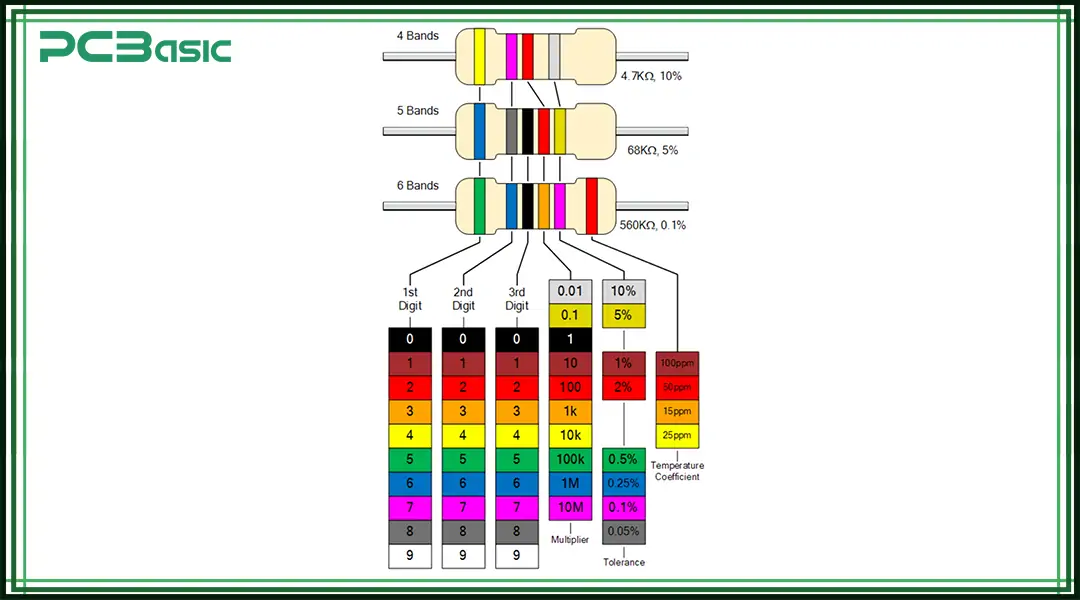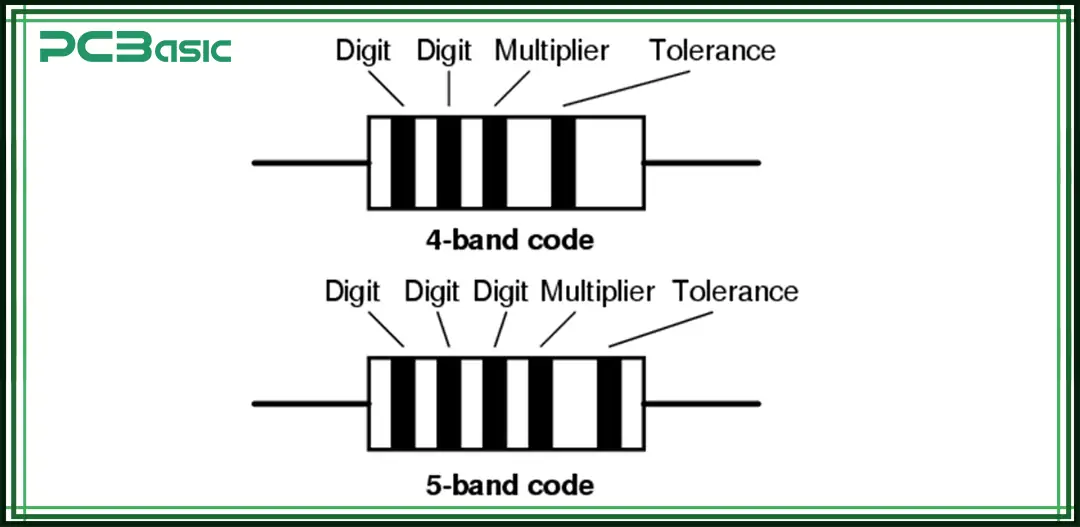Global high-mix volume high-speed PCBA manufacturer
9:00 -18:00, Mon. - Fri. (GMT+8)
9:00 -12:00, Sat. (GMT+8)
(Except Chinese public holidays)
Global high-mix volume high-speed PCBA manufacturer
9:00 -18:00, Mon. - Fri. (GMT+8)
9:00 -12:00, Sat. (GMT+8)
(Except Chinese public holidays)
HomePage > Blog > Knowledge Base > 100 Ohm Resistor Color Code: A Detailed Guide
Some of the most basic components that are found in electrical and electronic systems are resistors. Their main purpose is decreasing current flow, dividing voltage, and protecting sensitive elements. Since there are so many values of resistors, the need to distinguish them arises quickly, and this is particularly important in practical applications where efficiency and precision are key.
Given that it is not practical to mark such small components with text, manufacturers use a color coding system. This article describes in detail the color code system, and how it works, focusing attention on the 100 Ohm resistor color code, as well as how one is expected to read the bands of the resistor using visual and mathematical cues.

The practice of color bands on resistors is a result of the need for compact labeling. Most resistors are small in size, hence it is not possible to print numbers directly on their bodies. To indicate resistance values, tolerances and multipliers, the Electronic Industries Alliance (EIA) came up with a color coding system using colored bands. This system has now become universal in the electronics industry.
Each color corresponds to a numerical digit, allowing the user to interpret the resistor's value without additional tools. In laboratory environments or fieldwork, this enables technicians to identify components quickly without powering the circuit.
To aid beginners, tools like the resistor color code chart or a resistor color code calculator can simplify the interpretation process. However, with regular practice, reading color bands becomes intuitive.
A resistor color code follows a specific numerical value:
|
Color |
Digit (Bands 1 & 2) |
Multiplier (Band 3) |
Tolerance (Band 4) |
|
Black |
0 |
10⁰ (1) |
- |
|
Brown |
1 |
10¹ (10) |
± 1% |
|
Red |
2 |
10² (100) |
± 2% |
|
Orange |
3 |
10³ (1,000) |
- |
|
Yellow |
4 |
10⁴ (10,000) |
- |
|
Green |
5 |
10⁵ (100,000) |
± 0.5% |
|
Blue |
6 |
10⁶ (1,000,000) |
± 0.25% |
|
Violet |
7 |
10⁷ (10,000,000) |
± 0.1% |
|
Gray |
8 |
10⁸ (100,000,000) |
± 0.05% |
|
White |
9 |
10⁹ (1,000,000,000) |
- |
|
Gold |
- |
10⁻¹ (0.1) |
± 5% |
|
Silver |
- |
10⁻² (0.01) |
± 10% |
|
None |
- |
- |
± 20% |
Resistors may have 4, 5, or even 6 bands. The number of bands determines the coding scheme:
• 4-band resistors: two digits, one multiplier, and one tolerance band.
• 5-band resistors: three digits, one multiplier, and one tolerance.
• 6-band resistors include a temperature coefficient, mainly for precision applications.

To identify a 100 Ohm resistor, you need to read the colored bands that represent its resistance value and tolerance.
• Brown – 1
• Black – 0
• Brown (multiplier) – ×10
• Gold (tolerance) – ±5%
This sequence — Brown–Black–Brown–Gold — translates to (10) × 10 = 100 Ohms with a ±5% tolerance.
• Brown – 1
• Black – 0
• Black – 0
• Black (multiplier) – ×1
• Brown (tolerance) – ±1%
Here, the sequence — Brown–Black–Black–Black–Brown — gives (100) × 1 = 100 Ohms with a ±1% tolerance.
The choice between a 4-band and a 5-band resistor depends on how precise the application needs to be. For general-purpose circuits, a 5% tolerance is usually acceptable. However, sensitive electronic systems often require tighter tolerance, such as 1% or better, for more accurate performance.
Reading the color code of a resistor involves a systematic approach:
1. Determine Band Count: First, identify how many bands the resistor has—usually 4 or 5.
2. Identify the Starting End: The tolerance band (gold or silver) is usually spaced farther from the rest. Begin reading from the opposite side.
3. Use a Color Chart or Calculator: Tools like a resistor color code chart or calculator can assist if uncertainty arises.
4. Apply the Formula:
For a 4-band resistor:
Value = (Digit 1 Digit 2) × multiplier
For a 5-band resistor:
Value = (Digit 1 Digit 2 Digit 3) × Multiplier

Color bands Red-Violet-Orange-Gold
• Red = 2, Violet = 7, Orange = ×1,000
• Value = (27) × 1,000 = 27,000 Ohms or 27kΩ
• Gold = ±5% tolerance
With experience, technicians can quickly interpret resistor values without referring to charts or calculators.
 About PCBasic
About PCBasic
Time is money in your projects – and PCBasic gets it. PCBasic is a PCB assembly company that delivers fast, flawless results every time. Our comprehensive PCB assembly services include expert engineering support at every step, ensuring top quality in every board. As a leading PCB assembly manufacturer, we provide a one-stop solution that streamlines your supply chain. Partner with our advanced PCB prototype factory for quick turnarounds and superior results you can trust.
Even experienced individuals may occasionally misread a resistor if certain visual cues are overlooked. Here are the most frequent errors:
• Incorrect Orientation: Reading from the wrong side, particularly if the tolerance band is not obvious.
• Color Confusion: In dim lighting, brown may resemble red, and gold may look similar to orange. Always ensure adequate lighting or use a multimeter for confirmation.
• Ignoring Tolerance: Overlooking the tolerance band can result in using a component with unsuitable precision.
• Assuming Value Without Checking: Visually similar resistors can differ in value. Assuming that there is no verification may lead to a circuit malfunction.
In critical applications, using a resistor color code calculator or direct measurement with a multimeter is recommended.
The 100 Ohm resistor is a staple value in electronics. It offers moderate resistance and is suitable for many tasks. Typical applications include:
• Current Limiting for LEDs: A 100 Ohm resistor limits current to safe levels for standard LEDs operating from a 5V source.
• Pull-up or Pull-down Resistors: These are used in digital logic circuits to define default logic states.
• Signal Conditioning: Often found in analog filter designs where specific impedance values are needed.
• Microcontroller I/O Protection: Acts as a buffer resistor between microcontroller pins and external components.
• Audio and RF Circuits: Maintains consistent impedance or prevents oscillations in amplifier stages.
Because of its versatility, the 100 Ohm resistor is included in most starter kits and is commonly used in prototyping.
To wrap it up, the 100 Ohm resistor color code knowledge is not just an educational pursuit – it is a hands-on skill required for all people in electronics. The standardized system of the resistor color code is a time and cost-saving alternative to avoid extra equipment. A proper understanding and decoding of the color bands is crucial, whether you repair a device or assemble a circuit, since functionality and safety determine overall system performance.
Tools such as resistor color code calculators or reference charts are helpful for beginners. In a wide range of resistor values, one of such values stands out as essential, and that is 100 Ohm resistor, which is vital to hobbyists and professionals.

Assembly Enquiry
Instant Quote
Phone contact

+86-755-27218592
In addition, we've prepared a Help Center. We recommend checking it before reaching out, as your question and its answer may already be clearly explained there.
Wechat Support

In addition, we've prepared a Help Center. We recommend checking it before reaching out, as your question and its answer may already be clearly explained there.
WhatsApp Support

In addition, we've prepared a Help Center. We recommend checking it before reaching out, as your question and its answer may already be clearly explained there.
